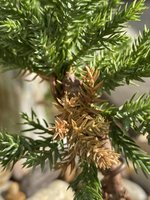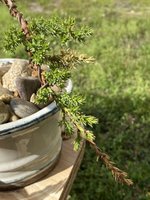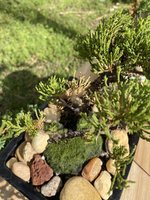I wouldn't worry about these branches as long as the majority are moving forward and producing tip growth (at this time of year, it'll be slower, but at 80F probably noticeable if you pick a vigorous branch to monitor week-to-week and compare pictures). I would worry about your soil setup though, and have some recommendations (more on this below).
First, something to know about many Juniper species: If you live in a juniper-rooting-friendly environment (sun, heat, humidity -- Florida will do) or construct such an environment in a greenhouse, you can chop a random small branch off a rooted mother plant, shove that unrooted branch into a basket of akadama/pumice/lava, and have it root within several weeks or a couple months (depending on conditions). I've had rootless juniper branches fire roots into straight air while sitting in a moist garbage bag on my garage floor. When you root rootless juniper branches (or juniper cuttings in general), you often lose a random distribution of branchlets / foliage across the rooted branch, but the rest survives.
Why am I talking about rooting cuttings? If you barerooted your juniper but kept the majority of the root architecture while doing so, then at the very worst, you're doing very well at the "shove a rootless branch into a basket" game, which is a game you can win. Junipers aren't as fragile as the internet makes them out to be. Also, if your juniper is still kickin' next summer, then you can take comfort in the fact that you don't have to go back in to do a followup and remove the oldest soil -- your barerooting reset you to have all-good soil, at least.
I don't know when you repotted, but if it was in the last couple months (as opposed to early summer or late spring 2021), then some branch loss could/should be expected just from the repot, because recovery should be slower at this time of year, even in central Florida. But stay the course.
Soil comments: You used akadama, pumice, and lava for your repot, so you already know the importance of using well-draining, durable, bonsai-appropriate soil. At the same time however, the decorative stones and moss that sit on top of your soil really need to go. These are directly impeding the flow of oxygen and creating imbalances in moisture and likely increasing moisture retention time, which is the opposite of what you want when you are recovering / colonizing a root system into a fresh soil mass. Remove all of that stuff, and going forward, monitor the surface and occasionally go in and remove cruft/junk/dust/invasive grass/etc. Ideally you want the soil surface to just be a nice even distribution of pumice/lava/akadama particles through which water and air can flow without impedance. A rapid cycle of dry / moist / dry / moist will get your roots back at full capacity the quickest, after which the canopy should begin to push growth much faster, allowing you to resume work on design goals. Do allow some drying to happen in the top 1 or 2 inches of soil before you water, water very thoroughly until it begins to escape out the bottom of the pot, hold the container up with your hands and tip it / bob it to wring out excess moisture (as if straining rice), then set it down in the sun. Repeat that ritual and keep the soil surface clean.





